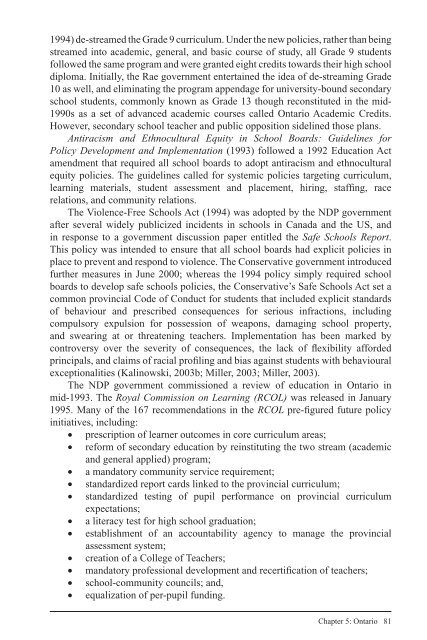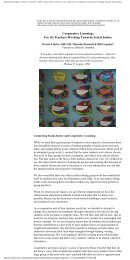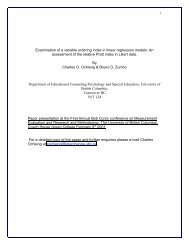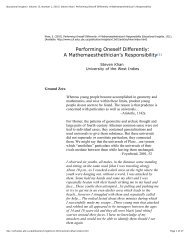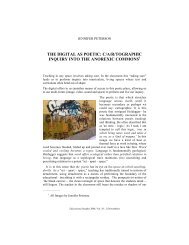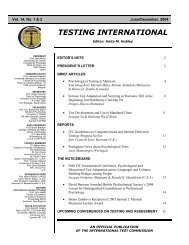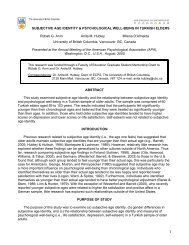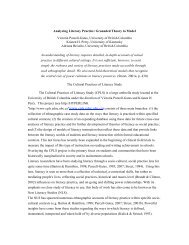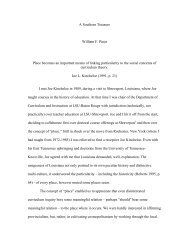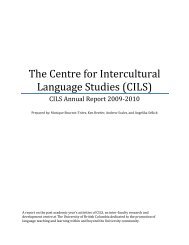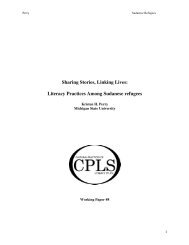The evolution of professionalism - Centre for Policy Studies in ...
The evolution of professionalism - Centre for Policy Studies in ...
The evolution of professionalism - Centre for Policy Studies in ...
You also want an ePaper? Increase the reach of your titles
YUMPU automatically turns print PDFs into web optimized ePapers that Google loves.
1994) de-streamed the Grade 9 curriculum. Under the new policies, rather than be<strong>in</strong>g<br />
streamed <strong>in</strong>to academic, general, and basic course <strong>of</strong> study, all Grade 9 students<br />
followed the same program and were granted eight credits towards their high school<br />
diploma. Initially, the Rae government enterta<strong>in</strong>ed the idea <strong>of</strong> de-stream<strong>in</strong>g Grade<br />
10 as well, and elim<strong>in</strong>at<strong>in</strong>g the program appendage <strong>for</strong> university-bound secondary<br />
school students, commonly known as Grade 13 though reconstituted <strong>in</strong> the mid-<br />
1990s as a set <strong>of</strong> advanced academic courses called Ontario Academic Credits.<br />
However, secondary school teacher and public opposition sidel<strong>in</strong>ed those plans.<br />
Antiracism and Ethnocultural Equity <strong>in</strong> School Boards: Guidel<strong>in</strong>es <strong>for</strong><br />
<strong>Policy</strong> Development and Implementation (1993) followed a 1992 Education Act<br />
amendment that required all school boards to adopt antiracism and ethnocultural<br />
equity policies. <strong>The</strong> guidel<strong>in</strong>es called <strong>for</strong> systemic policies target<strong>in</strong>g curriculum,<br />
learn<strong>in</strong>g materials, student assessment and placement, hir<strong>in</strong>g, staffi ng, race<br />
relations, and community relations.<br />
<strong>The</strong> Violence-Free Schools Act (1994) was adopted by the NDP government<br />
after several widely publicized <strong>in</strong>cidents <strong>in</strong> schools <strong>in</strong> Canada and the US, and<br />
<strong>in</strong> response to a government discussion paper entitled the Safe Schools Report.<br />
This policy was <strong>in</strong>tended to ensure that all school boards had explicit policies <strong>in</strong><br />
place to prevent and respond to violence. <strong>The</strong> Conservative government <strong>in</strong>troduced<br />
further measures <strong>in</strong> June 2000; whereas the 1994 policy simply required school<br />
boards to develop safe schools policies, the Conservative’s Safe Schools Act set a<br />
common prov<strong>in</strong>cial Code <strong>of</strong> Conduct <strong>for</strong> students that <strong>in</strong>cluded explicit standards<br />
<strong>of</strong> behaviour and prescribed consequences <strong>for</strong> serious <strong>in</strong>fractions, <strong>in</strong>clud<strong>in</strong>g<br />
compulsory expulsion <strong>for</strong> possession <strong>of</strong> weapons, damag<strong>in</strong>g school property,<br />
and swear<strong>in</strong>g at or threaten<strong>in</strong>g teachers. Implementation has been marked by<br />
controversy over the severity <strong>of</strong> consequences, the lack <strong>of</strong> fl exibility af<strong>for</strong>ded<br />
pr<strong>in</strong>cipals, and claims <strong>of</strong> racial pr<strong>of</strong>i l<strong>in</strong>g and bias aga<strong>in</strong>st students with behavioural<br />
exceptionalities (Kal<strong>in</strong>owski, 2003b; Miller, 2003; Miller, 2003).<br />
<strong>The</strong> NDP government commissioned a review <strong>of</strong> education <strong>in</strong> Ontario <strong>in</strong><br />
mid-1993. <strong>The</strong> Royal Commission on Learn<strong>in</strong>g (RCOL) was released <strong>in</strong> January<br />
1995. Many <strong>of</strong> the 167 recommendations <strong>in</strong> the RCOL pre-fi gured future policy<br />
<strong>in</strong>itiatives, <strong>in</strong>clud<strong>in</strong>g:<br />
• prescription <strong>of</strong> learner outcomes <strong>in</strong> core curriculum areas;<br />
• re<strong>for</strong>m <strong>of</strong> secondary education by re<strong>in</strong>stitut<strong>in</strong>g the two stream (academic<br />
and general applied) program;<br />
• a mandatory community service requirement;<br />
• standardized report cards l<strong>in</strong>ked to the prov<strong>in</strong>cial curriculum;<br />
• standardized test<strong>in</strong>g <strong>of</strong> pupil per<strong>for</strong>mance on prov<strong>in</strong>cial curriculum<br />
expectations;<br />
• a literacy test <strong>for</strong> high school graduation;<br />
• establishment <strong>of</strong> an accountability agency to manage the prov<strong>in</strong>cial<br />
assessment system;<br />
• creation <strong>of</strong> a College <strong>of</strong> Teachers;<br />
• mandatory pr<strong>of</strong>essional development and recertifi cation <strong>of</strong> teachers;<br />
• school-community councils; and,<br />
• equalization <strong>of</strong> per-pupil fund<strong>in</strong>g.<br />
Chapter 5: Ontario 81


